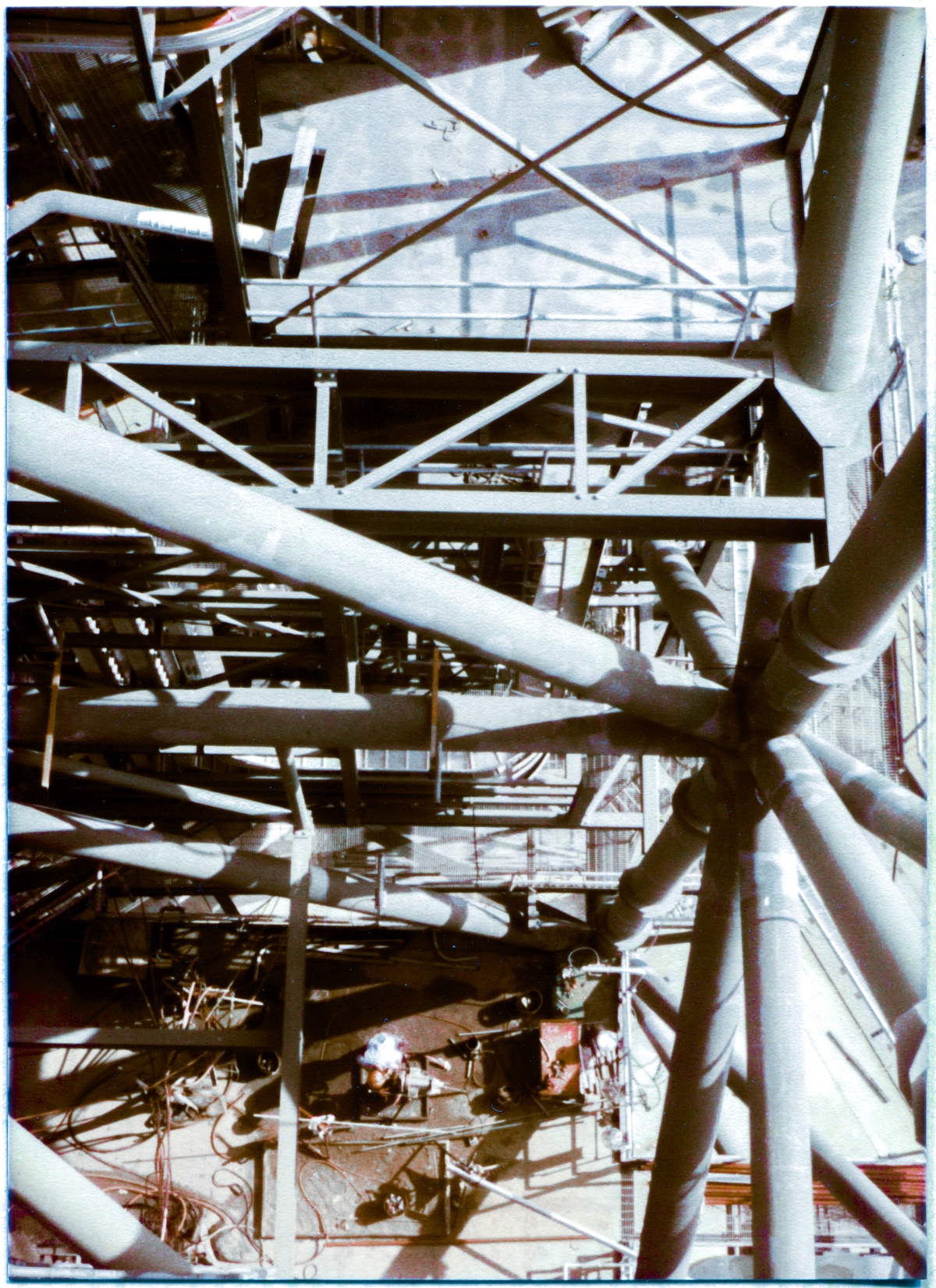The Construction of Space Shuttle Launch Complex 39-B
A very personal and technical written and photographic history, by James MacLaren.
Page 21: A Return to High Steel.
| Pad B Stories - Table of Contents |

You are back on the tower, once again, back on High Steel.
You are slightly above the general level of the roof of the RSS, standing at elevation 212'-7", above and outboard of the main envelope of the Payload Changeout Room, leaning with your hip against the handrail (you're not supposed to do that, but sometimes...) holding your camera out as far beyond it as you dare, looking down, in the direction of the Hinge Column, Between Lines A and B, much closer to Column Line B. Much closer to the face of the RSS. The bewildering complexity of what you're seeing is not to be denied, but there is reason to it.
There is order.
There is plan.
There is sense.
So let us see if we can extract perhaps a little bit of sense out of it.
We'll start with the heavy iron. The Primary Framing Steel of the Rotating Service Structure.
That which holds up all the rest.
We've already talked about Stub Clusters, and I'll not further belabor the subject at this point, but the center-right portion of this image is an excellent view of one of the more ferocious Stub Clusters on the tower, located at Elevation 171'-2" at the intersection of Column Line B and Column Line 2, with a pair of members (one of which is obscured in this image) extending forward, away from it towards Column Line C.
And surrounding the Stub Cluster on all sides... is everything.
But the deception factor is large in this photograph, especially as regards the elevations and locations of things.
For example, in the top portion of the image, above and to the left of the Stub Cluster, there is a whole area in here, with a large flat expanse of lighter-colored deckplates on one of the Hinge Column Crossover Platforms, with an equally-flat expanse of lighter-colored top-flange area on a truss located immediately below it on the photograph. These two items appear to be very-obviously adjacent to one another, located at the same elevation with a narrow gap between them, perhaps even connected in some way to each other side-by-side, as individual parts of some larger single unified system or object.
Not so.
The Crossover Platform is at elevation 171'-5" with its perimeter member closest to the truss located 12'-3" from the centerline of the Hinge Column, but the top flanges of the "adjacent" top support truss for a whole system of cable tray supports which descends below it are at elevation 180'-8 7/16" with their perimeter member closest to the crossover platform located 19'-3" from the Hinge Column, giving these two very-separate pieces of steel nine-foot three and seven-sixteenths inches of separation vertically, with an additional seven feet of horizontal separation between them as well. Additionally, the "gap" between them turns out to be the near-black shadowed side of the toeplate directly beneath the handrail run, with a very thin sliver of the platform framing member beneath, holding the smooth deckplates and handrail run along its perimeter, also in near-black shadow, completely indistinguishable from the toeplate, visually. Which means we're looking at an overlap, instead of a gap. Structural steel will fool you, every chance it gets, and it gets way more chances than you might at first imagine it would.
But you'd never guess any of that, just from looking. Structural steel is notorious for these sorts of deeply-misleading chance alignments, and even when you've become accustomed to this phenomenon, and are properly vigilant for it, it will still occasionally get you, and cause you to badly misapprehend that which you are staring directly at, and in a partially-constructed working environment this constitutes a very real danger, and can result in wholly-unexpected situations which have the power to come up on you suddenly, occasionally with very real consequences. Things that aren't there, are suddenly there. Things that are there, are suddenly not there. So yeah. So we be real careful about plainly-visible things that we're staring right at, ok? Occasionally, they are no such thing at all.
Below, beyond, and to the left of the Stub Cluster can be seen what we were dealing with on a daily basis, in all of its apparently chaotic (but in fact, very tightly-organized) glory.
Part of me will always miss this place, but it's gone forever.
Eight stories below you, down on the RSS Main Floor level at 135'-7", a zoom of the lower portion of the image will reveal the day-to-day details of a one-five-hundredth-of-a-second slice of the ongoing work on the towers.
Gang box, air hoses, conduits, beams, deckplate, steel-bar grating, cord, ropes, pipes, a float, cable trays, posts, columns, primer-coated steel, gusset plates, clip angles, stiffener rings, high-strength structural bolts, power cords, explosion-proof lighting fixtures, air duct, buckets filled with bolts, tools, and trash, sticks of firex piping, loose cribbing lumber, hangers, knee-braces, handrails, emergency eye-wash station, catwalks, platforms, diagonals, full-penetration welds, and even a gentleman in an orange hard hat, bent over his work, pursuing his trade.
It's all there, and more too, including a bit of the Pad Deck and just the tiniest sliver of the Flame Deflector crest beyond its margin, complete with a couple of Spray Headers visible, and beyond that, an even tinier sliver of the bottom of the Flame Trench, north of the Flame Deflector, shrouded within shadowed gloom, over two hundred vertical feet beneath you.
Return to 16streets.comACRONYMS LOOK-UP PAGEContact Email Link |